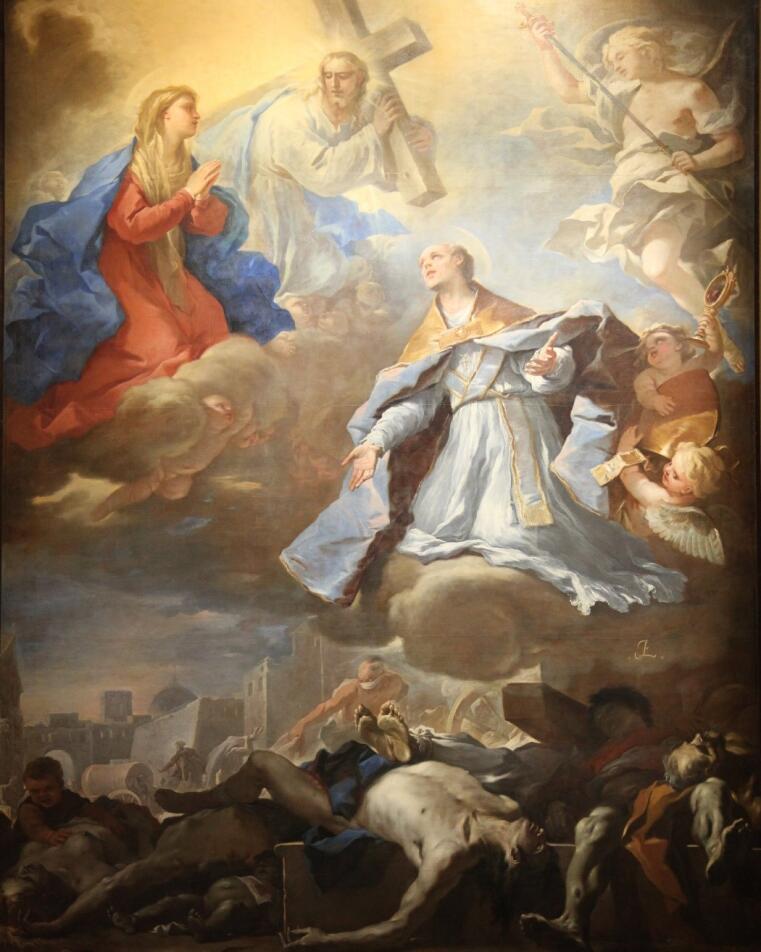Visibility of the invisible: a saint prays in heaven for the victims of the plague on earth
By Jens Niebaum
In 1656, Naples was struck by a particularly serious plague epidemic, which claimed almost half of its inhabitants in the space of four months. Many of the dead were buried outside the walls in hastily constructed mass graves, including the Grotta degli Sportiglioni, where, according to one chronicler, no fewer than 60,000 people were buried. A number of citizens and guilds, as well as the Viceroy of Naples, had a church dedicated to the Madonna del Pianto (St. Mary of Weeping) built in this place of horror between 1657 and 1662, to hold requiem masses for those often buried without the last sacraments. The church was given three altarpieces, including the ‘Intercession of St. Januarius for the end of the plague’ by the Neapolitan painter who was then young but who would later be celebrated throughout Europe, Luca Giordano.

The painting comprises several layers that are complexly intertwined with one another. At the bottom are scenes that must have taken place every day during the epidemic in places like the Grotta degli Sportiglioni. In the foreground, the corpses, man and woman, young and old, are piled up: a mother for whom her baby is weeping, a child with open mouth and bloated belly to which a bloody cloth is stuck, a man lying on his back, a bleeding bubo on his upper thigh, a dead man wrapped up, his head disappearing under a coffin. We can see behind his bare feet a muscular gravedigger naked from the waist up, who has a cloth tied around his nose (apparently a precursor to today’s masks) to protect himself at least from the stench. Behind him, a colleague is dragging on his back a dead man hanging upside down in a shroud, while a covered wagon driving straight out of the city gate drives up more corpses. The epidemic is shown here in the obvious physical and social effects that it has: deformation and dehumanization of the victims, horror and grief of the bereaved, the back-breaking work of the gravediggers.
Above this scene of horror, the tone changes. Several figures appear here on clouds, staggered according to height: on the right in the middle register is St. Januarius, the patron saint of Naples, kneeling in episcopal vestments and praying for his tormented city. Putti are holding the reverentially deposed mitre and the ostensorium of the famous ampullae of his blood as a pledge of heavenly grace. The saint is turning to Mary in the upper left-hand corner, who with folded hands passes on his intercession to the Christ carrying the cross in the upper centre of the picture. What is depicted here is a staggered intercession, from the patron saint of the city to Mary, the most important intercessor and corredemptrix, to her divine son. By presenting him as the bearer of the cross (whose nail holes are clearly visible), the accent is placed on his own suffering as well as on the instrument of redemption. The effect of this intercession is visualized in the upper right-hand corner, where an angel is putting the drawn sword back into its sheath: derived ultimately from the Biblical account of the plague in David’s time (1 Chronicles 21:27), this image represents the end of the epidemic.

The actual theme of the painting is not the plague itself, but rather the ‘mechanism’ of making an intercession and being heard that, according to common perception, had brought about the end of the epidemic. How, then, did the painter make these processes, which are so difficult to visualize, visible? First of all, he clearly marks the categorical otherness of the heavenly and earthly spheres. Even the clouds unmistakably mark the constitutive break in reality, which is emphatically reinforced by the colouring of the figures: Christ and the avenging angel become, as it were, light-suffused apparitions before or at the height of the divine light, while the intercessors Mary and Januarius, located on a middle level between divine and earthly figures, appear in comparatively strong colours. Under their clouds, on the other hand, the dead are clearly shrouded in deep shadows. In only a superficially paradoxical way, the earthly dead are dematerialized, as it were, while the immaterial in the heavenly sphere are substantiated, and thus made visible as the protagonists of the actual event.

As clearly as the earthly and heavenly spheres are separated, so emphatically is marked on the other hand the permeability of this separation, which is constitutive for the event. Thus, a light shines here and there into the realm of shadows under the clouds, and creates chiaroscuro-like effects. But Luca Giordano also ties together the earthly and heavenly worlds in how he composes the picture. For example, the sequence of directions of gaze and prayer connects Christ, Mary and Januarius in a zig-zag line, which continues unmistakably in the earthly world in the movement of the gravedigger’s arm and the lower leg of the dead man lying before him. And another compositional line leads from the crossbeam of Christ’s cross diagonally over the upper body and stole of Januarius, down to the deeply shadowed dead man in the lower right-hand corner of the picture. This also emphasizes the role of the saint as intercessor of Naples, while underlining at the same time the relevance to the city depicted, where an almost inconceivably large number of dead Neapolitans, buried invisibly in the mass grave under the church, hoped to reap the fruits of the intercession performed liturgically and depicted here in this painting.

